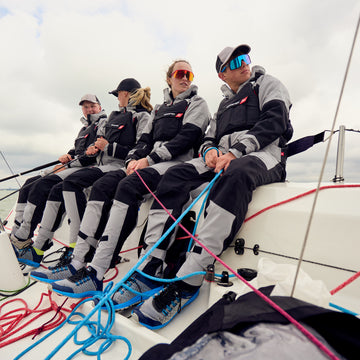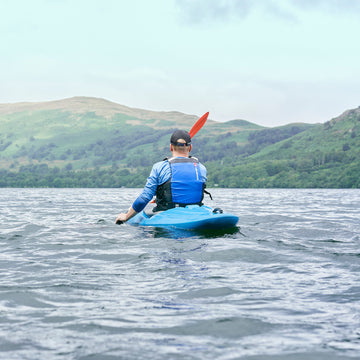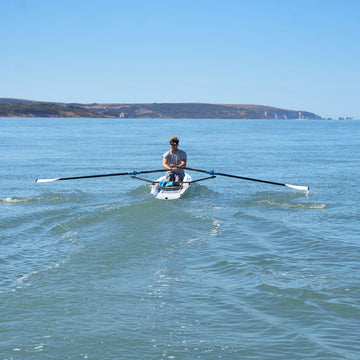16 knots sea breeze and we were allowed to go out to play at Lee on Solent Sailing Club. I plugged in my speed puck to get some numbers and help us focus on our training.
I was keen to see how windy we could cope with our light wind gybe technique. The process involves ensuring the boat is flat level and balanced, then easing the mainsheet and re cleating. This generates enough windward heel to start the gybe. Then I can focus on un-cleating the wing wang, pushing hard on my feet to keep the boat turning, whilst Sarah also remains committed to the windward side (this keeps the boat turning).
There is a moment after the un-cleat of the wing wang that I can pull the boom over with the mainsheet (check out our RS400 Mainsheet) before pulling the new windward wing wang on before it loads up. We leave the jib to last. Sarah un-cleats and I try and re cleat so she can concentrate on flying the kite to get us back up to full speed.
Much more wind and waves than this (it was about 16 knots with wind against tide) I would tend to go for safety by easing and resetting the pole in the centre (cleating both sides) before the gybe which ensures I can play the mainsheet through the gybe to ensure we maintain the correct balance. After the gybe, I can then un-cleat the leeward and pull like mad on the windward wing wang line to square the pole.
The most important part of gybing is not moving inboard too early, but committing to the windward heel - which makes the rudder follow. If you have the boat heeled to leeward before the gybe - the rudder simply lifts the back of the boat and buries the bow which makes for a big swim. Not fast - and very tippy. Check out the rudder instigated gybe on the Downwind Boatwhisperer DVD. The secret is letting the boat do the turning - not the rudder.
Happy training. :)
Some great comments:
Paul Hilliar
Where we ended up was that if we are both on deck then you get a more reliable and overall faster gybe if you centre the pole unless you are on pan flat water. You can steer a faster arc, come out on a hotter angle, the helm can hit the toestraps laser-style 2 seconds earlier, less chance of steering into a wave. Speccy made the swing pole gybe work when it's windy but his level of skill is outstanding. And always, always, un-cleat the jib - preferably pre-sheet it on the other side a little.
We used jib fairleads and 7mm polilite sheets so the jib could be sorted post-gybe with no faff. I know doing a centre pole gybe leads to a post-gybe pole faff but we found 10% of swing pole gybes go wrong, sometimes badly.
It's not my area but I think your crew should take more kite sheet and do 'The Superman Kite sheet punch' (Musto Skiff style) in order to cut a bit of time to the kite filling. I miss RS400's....... Such a great boat.
Jim Downer
I was watching your FB post on gybing a 400 with interest and thought id give my thoughts and Jon and I’s experience with them, especially when we weren’t sailing at 165kg and could bounce the boat up easily (we started in the 400 at about 145kg a long time ago and bouncing up a 400 isn't easy at that weight). I'm not trying to criticise anything you guys, or anyone else, do, it's more of a “this is what we used to do”, take from it what you want! Its also badly written and a complete brain dump so do excuse!
So, I split gybes into 2 categories: quite simply the boat is either planning or not, so planning or non-planning gybes. The non-planning is your standard slow-paced roll gybe, nice big arc etc etc. My thoughts are fairly well documented in the Mark Rushall DVD so I won't go into it, but (due to timings never working) we never got round to spending a few windy days with Mark, and Peter Barton did the windy stuff. So here are my thoughts: The planning gybe is obviously a little different, but not hugely. But this can be split into three separate categories:
1. The easy no speed loss gybe. This is your stereotypical, long arc, perfectly timed on the wave which sees minimal speed loss. Normally seen executed by the leader who has time to execute such a manoeuvre.
2. The punchy, but planned, attack gybe. This is the violent turn gybe. The one you know is coming but not too sure when. For example, you’re sat on someone's stern as you approach a layline, they’re an easy overtake if you gybe in their wind, but you don’t know when that will be and may have a second to react to them gybing in front. Or you have someone on your tail planning the same thing and need to throw in a split second gybe to shake them. It all sounds risky in 20 knots but with practice is very doable and a great weapon!
3. The crash gybe! As it says on the tin… the ”where did that starboard gybe f****r come from?” throw a gybe in and pray kind of gybe. Similar to the attack gybe but without any planning. So the big difference between all is what the helm does during the gybe. Which also means that 90% of the gybes (if you have a half-decent crew, which I’m sure Sarah is) going wrong, is down to the helm.
So let's start with the crew and what they do….. Work miracles!
Obviously, every gybe is slightly different so some common sense and improvisation is required from said crew, but if they are confident and get it right, you can jack knife the tiller, turn on a six-pence in 20 knots and not capsize! Their job is pretty similar throughout. Communication is key: the helm (or whoever does tactics downwind) tells the crew everything and the key here is the word gybe, perhaps its “looking to gybe as we are near lay”, “I want to gybe on this guy” “I think we should gybe in this lift” etc. The sooner the helm mentions it, the sooner everyone can start preparing. So once crew hears that a gybe is imminent, they are preparing to go. We all know in the real world the RYA standard “3…2….1….Gybe-oh” is replaced by “gybing” so the more they do, to prepare for the inevitable, the better. There's not actually much to do, first is be tangle-free, the second is to take all the slack out of the windward sheet, the third is to keep hiking for speed.
Next comes the turn: this is where things get a bit different from gybe to gybe depending on the helms turn rate. In your perfect (gybe one) no loss of speed gybe, as the boat turn, the crew takes the sheet from the windward block, as close as possible (i.e. by their forward thigh) and let go of the old sheet. You can trim the kite happily from the windward sheet for some time, like the helm does in the hoist, so the crew should get practised in this. What this does initially is fire the clew in the air, opening the leech and rotating the kite round to windward, helping and accelerating the turn. The clew also comes up towards the forestay, so is effectively halfway across. Then in one motion as the boom is coming across, they push forward with their front hand (think superman flying), stand and move quickly toward the new gunwhale. Their aft foot (soon to become forward foot) lands just above the toe strap, they pirouette, feet hooks toe strap and they launch outward….just like roll tacking a laser. Their aft hand, with the sheet, is above their head and the kite is full on the new side and hopefully over sheeted as they have just moved the kite sheet through 9 foot. The over-sheeting is the critical bit as this stops the boat spinning into the wind when inevitably the helm f**ks up. And also allows for any forward movement of apparent wind. They then, in a split second, assess how the gybe went/feels. If it was smooth and under control, they then ease the sheet to trim, or they sheet in further, with their spare hand, oversheeting some more if they feel the capsize coming! What this allows, when the crew has got the hang of it, is the helm to come out of the gybe hot! Which is fast! And the boat to almost roll gybe, which it will due to inertia if the turn is sharp! That’s it for the crew. It's that easy, but that critical! Notice they didn’t touch the jib! The helm does that! And also notice how the crews arse NEVER touches the thwart in the gybe! NEVER EVER! The timings on the windward sheet can go from a few seconds, prior to a long perfectly arced gybe to the split-second crash gybe. The helms priorities change with the 3 types of gybe.
1. With a perfect, no pressure gybe, I set the wing wang as soon as I think (and say) about gybing, getting close to a layline etc. I centre it, take the slack out of the other side and then get back to windward and hike. From there I take the slack out of the windward jib sheet, pull a foot or so more onto windward, so it is now flying off that sheet, cleat it and un-cleat the leeward. Its pre gybed! Then on the perfect wave I bear away in a nice wide arc, keeping the mast above us, minimal roll, step across the boat, flick the main from the purchases, pirouette on my aft foot, hike hard, and correct the rudder angle accordingly. I'm turning 80-90 degrees with confidence and coming out quite hot. The mainsheet is in my hand. I hike hard, get sailing and deal with the wing wang later….maybe, there's no rush. Going into the gybe the end of the boom is inside the gunwhale, so it doesn’t take too much to flick across and there's minimal momentum as it blows over. The mainsheet is not cleated! It should all feel effortless!
2. The violent turn. This is where the crew work really pays off. As before, you prepare exactly the same, centre the pole, sort the jib and hike hard. The next bit in an ideal world is where you revert to the paragraph above and execute a perfect gybe, but inevitably it doesn’t work like that. Perhaps the turn rate is fast and sharp, perhaps you have to gybe up a wave, or with a boat about to roll you out of a gybe. You are still looking to come out hot, you will feel like the capsize is inevitable, the boat is broaching, but with the correct crew work, you won't capsize! So as before, all set up, then you turn, shout “gybe” and make it across the boat as fast as possible, hit the deck like a school kid in a bundle and assess the situation. If it's all good and under control, proceed, if not, the boat has rolled excessively, you’ve come out too high etc throw the uncleated main sheet at the cleat, the main dumps, the oversheeted kite out balances the boat and the boat instantly becomes safe, bears away and normal trim can resume. Small movements of the rudder can be used to bear the boat away but anything excessive will make it worse…..there's a great DVD on that, called the boat whisperer, you may have heard of
3. Basically when there's no pre gybe prep! This is when what the crew does is REALLY key! That ability to oversheet combined with the main dump is critical! We assume you have to gybe out of the blue, the helm is pulled hard and you begin to cross. Without letting go of the mainsheet, which shouldn’t be cleated (I raise the ratchet to make it really hard to cleat), I go for the wing wang, uncleat it and then grab the new one. If its rigged right, with a nice hose pipe loop, it should be there, standing up at the cleat ready. Grab it with your mainsheet hand (never let go of the mainsheet) and pull as you cross. Never worry about getting it all the way across, but it is critical to get it above centre, as with any heel (which there definitely will be), when that pole catches the water, it’s a recipe for disaster! Let go of the wing wang, hit that gunwhale with all the force you can muster, this momentarily bounces the rig and expels power and throw the mainsheet at the block to ease! With the kite over sheeted, again, 95% of crash gybes can be saved like this. If it's going wrong and you’re on your arse in the middle of the boat, prioritise dumping main and getting pole out of the water! The jib…who cares, it’s the least of your worries and a backing jib will probably help when the inevitable broach starts! I tend to resist counter steering the rudder excessively after any gybe. If you blow the main and counter steer, all the physics go the opposite way and you'll end up swimming to windward. The kite over sheeted and main blow combo should be adequate. It is fast and more logical to gybe the pole mid gybe, much like the crash gybe, but we found this VERY high risk in anything more than say 16 knots. And the gains are minimal. I think its better practice to centre, but worth practising because it has to happen at times! Great practices are: when flying downwind, the helm shoves the helm to leeward initiating the broach and crew tries to oversheet to compensate and save. Then move into coming out of gybes high. Start in 12-14 knots, turning through say 90-100 degrees and build on that. I don’t ever mention survival gybes. They shouldn’t exist. That’s sort of it. Id say in 9/10 gybes we did in 20 knots +, the boat would initiate a broach, but we always saved it, and it was fast! Hopefully, it all makes sense. I'll try to get some video when we can get out in a 400 again.
And for the record, right now, having done only garda and two bloody marys in the last 3 years in the 400. We could not practice what I preach! haha..
See the video here:










 Select Store
Select Store
 EU
EU
 US
US
